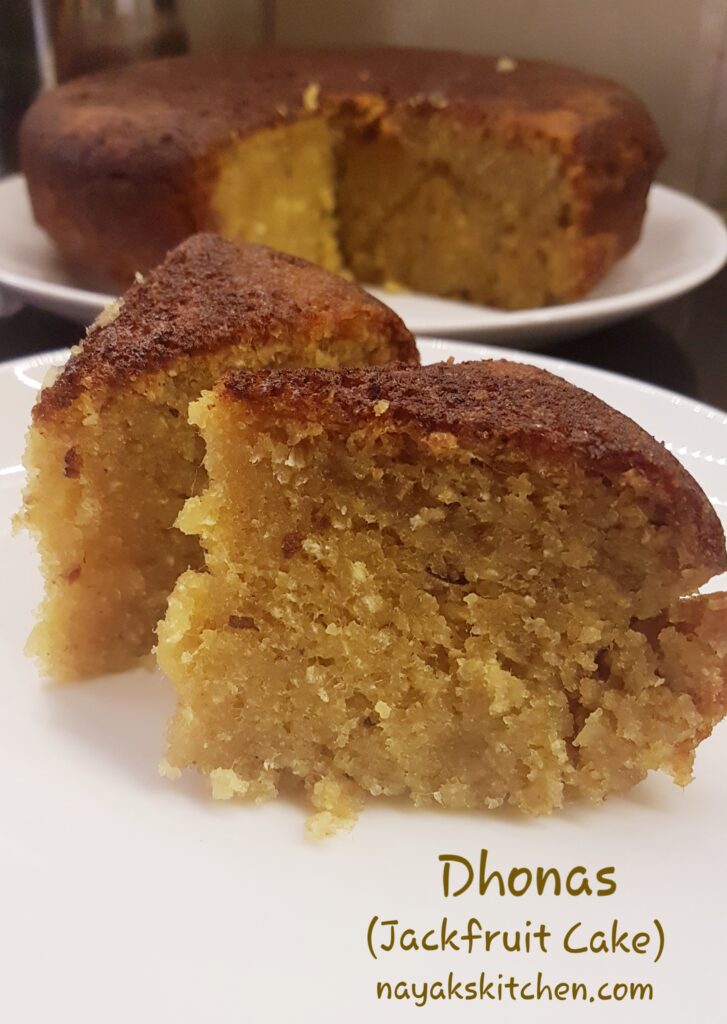Raw Jackfruit Recipes | Panasakaya Biryani | Vegan Biryani Recipe | Panasa Biryani
Raw Jackfruit Biryani with step-by-step photos and detailed instructions.
Are you a non-vegetarian who has turned into a vegan or vegetarian? Then this raw jackfruit biryani is a must try if you miss your chicken biryani.
Raw Jackfruit biryani is a vegetarian variant of chicken biryani as the succulent jackfruit pieces emulate the texture of meat. This one-pot veg biryani recipe is not only comforting but also satiating.
Raw jackfruit has a low glycemic index and a lot of fibre which prevents sugar spikes thus preventing you from bingeing.
During summers, when raw jackfruits are available in plenty, I sometimes prepare this biryani. It’s a perfect meal on a veg day when you crave something spicy and comforting.
Do try out this flavourful kathal dum biryani. Although the recipe seems to be long, do not get overwhelmed. Read the recipe first and keep all the ingredients ready. Do all the needed pre-preps and follow step-by-step. Also, check out the biryani tips given in the post.
What is Jackfruit Biryani?

Jackfruit Biryani is a biryani where tender jackfruit is marinated with curd, ginger-garlic paste, mint leaves, spice powders, etc. The marinated jackfruit pieces are then cooked first and then the biryani is layered alternatively with cooked basmati rice, jackfruit pieces and mint leaves. This layered biryani is then ‘cooked on dum‘ to infuse the flavours.
Cooking on dum is a traditional cooking technique wherein a dish is slow-cooked in a sealed pot or container, typically over low heat, to allow the flavours to blend. The term “dum” means steam in Hindi, which is produced when the food is cooked in a sealed pot.
The technique is often used in the preparation of biryanis, stews, and curries, and it is used with different types of meats and vegetables. Cooking on dum allows the food to cook in its own juices and results in a tender, flavourful dish that is moist, succulent and aromatic.
Raw jackfruit biryani is a popular dish in South Indian cuisine. It is typically served with raita, a curd-based side dish. Jackfruit biryani is a flavourful and satisfying meal that can be enjoyed by vegetarians and non-vegetarians alike.
This delicious and flavorful dish is popular in many parts of India, especially in the southern regions. Also, it is a great option for vegetarians looking for a tasty and healthy meal.
Raw Jackfruit


Raw jackfruit is called ‘Kuvlo’ or ‘Chaako‘ in Konkani. In Hindi, it is called as ‘Kathal‘, ‘Kaccha Fanas‘ in Marathi (Kaccha means raw), ‘Panasapandu‘ in Telugu and ‘Halasu’ in Kannada.
Unripe jackfruit is green in colour and is spiky on the outside. It is a tropical fruit that grows in abundance in Asia, Africa and South America.
In India, jackfruit grows in the tropical regions of southwest India. It is the largest among all tree fruits. Both unripe and ripe fruits are used for different culinary purposes.
It is the state fruit of Kerala and Tamilnadu. Also, India is the largest producer of jackfruits in the world. In Goa, you will find a jackfruit tree in almost every household in the rural areas.
There are many tender jackfruit recipes in Indian cuisine.
Raw Jackfruit Taste & Texture
Raw jackfruit has a neutral taste and flavour. Hence, this makes it easier to adapt to different recipes because of its capacity to absorb the aroma of the spices used in cooking.
Kathal or jackfruit has a fibrous texture, similar to meat; hence, it is popular amongst vegetarians and vegans. Moreover, it is affordable and sustainable as compared to other plant-based meat alternatives.
How to cut a raw jackfruit?


Cutting raw jackfruit is a cumbersome process if you are a novice. However, with little practice, the right tools and technique you will be able to cut a raw jackfruit like a pro.
The latex or sap (called dheekh in Konkani) is very sticky. It clings to everything and that is what makes the process annoying.
The best way to manage the sap is to use oil liberally. Hence, oil everything well. Your hands, knife and cutting board too. However, if the sap spills over the counter do not use soap to scrub or clean. You will make matters worse. Just apply oil and wipe it off with an old piece of cloth or tissue paper.
Hence, use oil, as it prevents the sap from sticking to the surface of anything. Also, keep applying oil to your hands in between as required.
For a detailed tutorial on how to cut a raw jackfruit easily check out the post below.
Here you will get detailed step-by-step photos and instructions.
Cutting into chunks or shreds
How you cut the jackfruit depends on the recipe you will be using it for. For example, you must keep more of the edible part for raw jackfruit biryani to retain the chunks post-cooking.


Whereas, you need to shred the chunks for the Goan Chaako recipe (raw jackfruit sabzi). Hence chop more of the hard white part (as it doesn’t become soft upon cooking) along with the outer rind.
Benefits of raw jackfruit
Raw jackfruit has many health benefits. It should be included in the diet when in season.
- Rich in fibre – Raw jackfruit is a great source of dietary fibre that promotes regular bowel movement and prevents constipation.
- Digestive health – Improves digestion and thus supports gut microbiome.
- Weight Loss – Due to its fiber content it keeps you fuller for longer and prevents overeating.
- Nutrient-dense – Rich in vitamins, minerals, anti-inflammatory compounds and phytonutrients such as saponins, flavonoids, and lignans.
- Boosts immunity – Raw jackfruit is a good source of Vitamin C that is important for immune function.
- Regulates blood sugar levels – This is primarily due to the high fiber content and low glycemic index of raw jackfruit.
Although green jackfruit is a powerhouse of nutrition, it should be consumed in moderation.
Biryani Ingredients
Here is a list of some of the main ingredients you will need for the raw jackfruit biryani recipe:-
- Raw Jackfruit
- Basmati Rice
- Curd
- Ginger-garlic paste
- Whole Spices
- Spice powders
- Biryani Masala
- Mint leaves (Pudina)
- Fried Onions
- Tomatoes
Biryani Masala
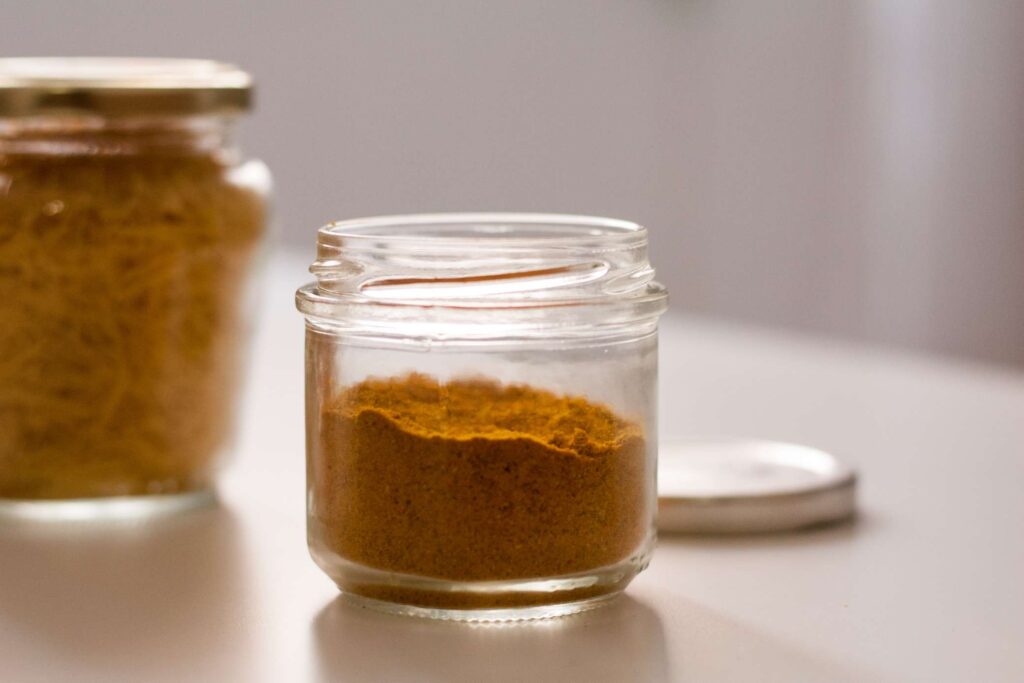
Biryani masala is a combination of different spices that gives the biryani its unique and distinct flavour. A good biryani masala contains a blend of aromatic spices like cardamom, cloves, cinnamon, coriander, cumin, and fennel seeds.
These spices are roasted and ground to create a fragrant powder that is used to flavour the biryani.
Using a good quality, well-balanced biryani masala is important because it can greatly enhance the taste and aroma of the biryani. A low-quality biryani masala can make the biryani taste bland or overpowering.
Different regions in India have their variations of biryani masala giving each biryani a unique regional authenticity. Making your biryani masala at home is also an option, and it allows you to customize the blend of spices to your personal preference.
In summary, a good biryani masala is important for biryani because it adds richness, a complex flavour profile, and depth of flavour to the biryani.
There are many readymade biryani masalas available in the market. You can use any one that has a good flavour and aroma.
For the raw jackfruit biryani recipe, I have used ‘Nawab’s Secret‘ biryani masala. They have many variants like ‘Hyderabadi Biryani Masala’, ‘Lucknow Biryani Masala’ etc. Their masalas are fragrant and aromatic. For a spicy biryani you can use, Hyderabadi Biryani Masala and for a more sober, less spicy biryani use Lucknow Biryani Masala. These masalas are available on Amazon. I will share the link to buy these masalas below.
(Please Note: This is not a sponsored post. This is my personal review and just a suggestion. You can use any Biryani Masala of your choice.)
Birista (Fried Onions)

Birista is nothing but deep fried onions that are used as a garnish or topping in Indian cuisine. The onions are sliced thinly and then fried in oil until they are crisp and golden brown.
Birista is used in different dishes such as biryanis, pulao, kebabs, curries etc. It adds a slightly sweet and caramelized flavour to the dish. The aroma of fried onions is very enticing and adds a fragrant crunch to the biryani.
The crispy fried onions enhance the overall taste of the biryani. So do add it. In some regions, birista is also known as barista or beresta.
Tips

- Selecting the raw jackfruit – Always select an unripe, young jackfruit that is hard and firm to touch. You can also use canned jackfruit.
- Jackfruit Seeds – Use the jackfruit seeds if they are tender, and their outer hard covering has not formed yet.
- Cooking the jackfruit – Raw jackfruit takes a long time to cook in an open pan. You can pressure cook it till tender, to reduce the cooking time. If cooking in an open pot, do check in between for water content. If required add a little water.
- Soaking the rice: Soak the rice for a minimum of 30 minutes before cooking. Soaking will cook the rice evenly and prevents it from becoming mushy. It also will give you rice that is fluffy and has long grains.
- Cooking the rice – The rice should be 80% cooked as it will cook further after layering the biryani.
- Use whole spices such as cardamom, cloves, cinnamon, and bay leaves to instill the biryani with a fragrant aroma.
- Biryani Masala: Use good-quality biryani masala. Your biryani’s taste and flavour will depend on the masala that you use.
- Salt – Be careful while adding salt. Most biryani masalas have added salt in them. Check for the ingredients on the label before adding additional salt.
- Layer the biryani: Layering the biryani by alternating between the rice and jackfruit mixture will ensure that the flavours are evenly distributed through the rice.
- Fried Onions (Birista): This is one of the most important and the secret to a delectable biryani. Do not skip it.
- Mint and Coriander – Add the required freshness and also balance the hot spices that might overpower the biryani.
- Use a heavy-bottomed pot: This will prevent the rice from sticking to the bottom and burning. You can even use a mud pot.
- Cook on low heat: Cooking the biryani on low heat and dum ensures that the rice is cooked evenly and doesn’t get overcooked or mushy.
- Allow it to rest: After cooking the biryani, let it rest for at least 10-15 minutes before serving. This will infuse the aroma in the biryani.
Serving Suggestions
Here are some serving suggestions for the kathal biryani recipe:-
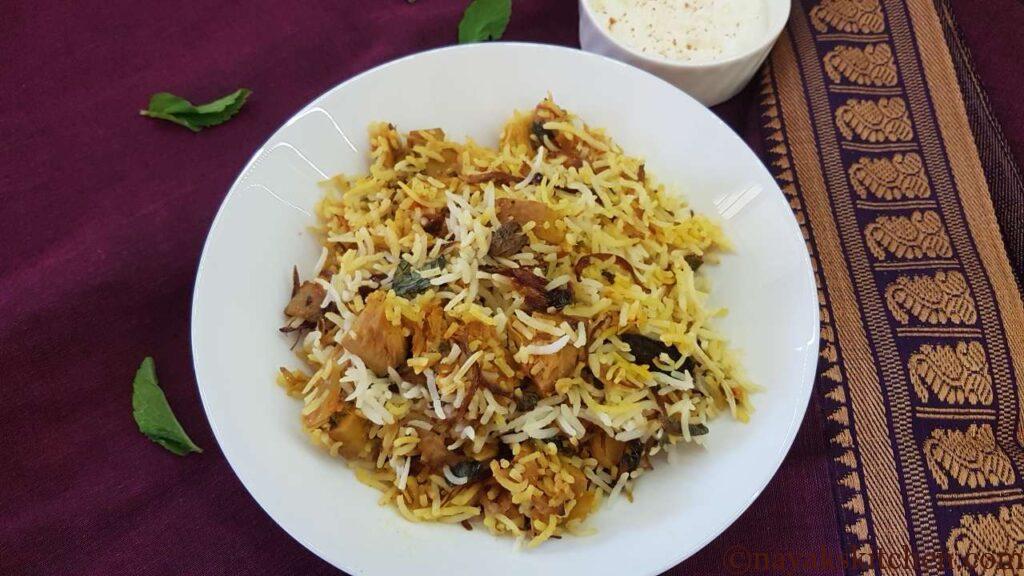
Serve hot jackfruit biryani or kathal ki biryani with a cooling raita of curd, cucumber and mint. It can be served with plain curd too. You can also serve with crispy and crunchy papadums.
Raw jackfruit biryani also goes well with a tangy and spicy chutney. It is a great accompaniment to kathal dum biryani. You can make a simple mint and coriander chutney or a spicy tomato chutney to serve alongside.
Kathal ki biryani also pairs well with a pickle or salad. Serve a simple salad of onions, sliced cucumbers and tomatoes with a dash of lemon juice.
How to make Jackfruit Biryani?
i) Soaking Basmati Rice
- Clean the basmati rice and wash twice with water. Drain the water completely. Add water again and soak it for 30 mins.



ii) Marinating Jackfruit
- Take the jackfruit pieces in a wide bowl and add curd. (If you are a vegan, replace with a vegan curd.)


2. Add ginger-garlic paste, turmeric powder, chilli powder and coriander powder.




3. Add biryani masala, chopped mint leaves (pudina), ghee and salt.
(Note: Skip ghee if you are a vegan. Check the ingredients of biryani masala for added salt. Adjust accordingly.)
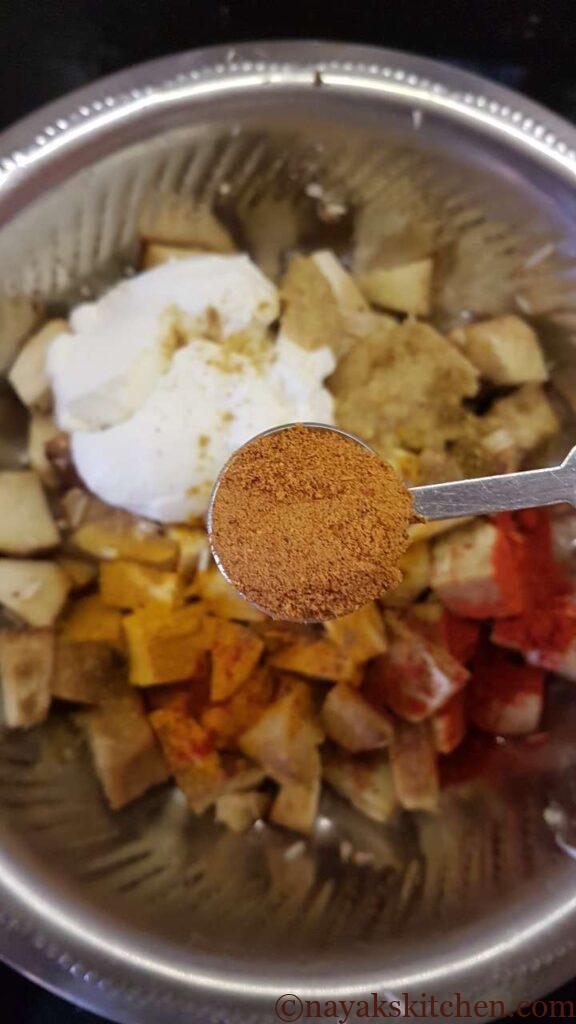

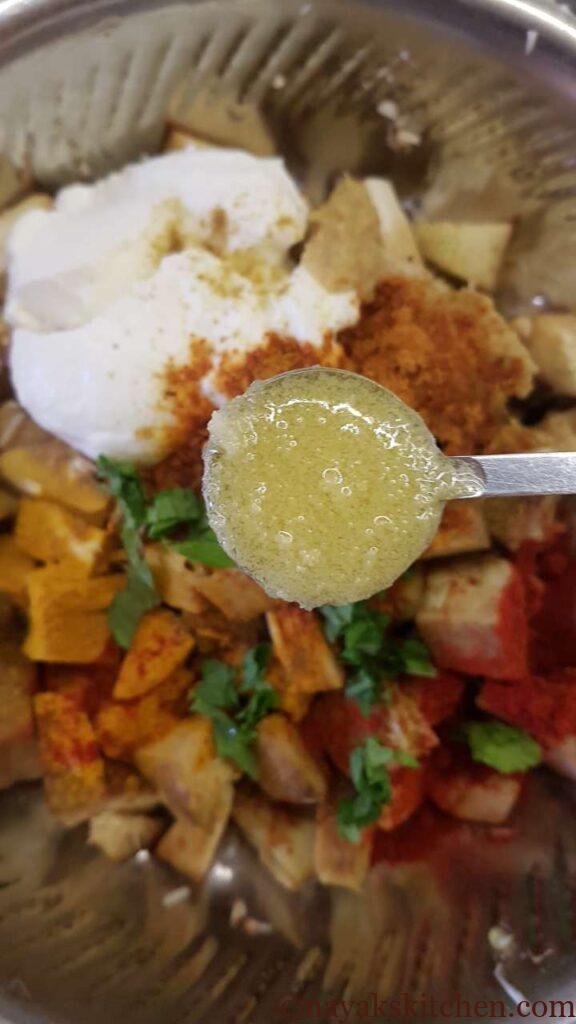

4. Mix everything well and keep aside covered for 30 mins.

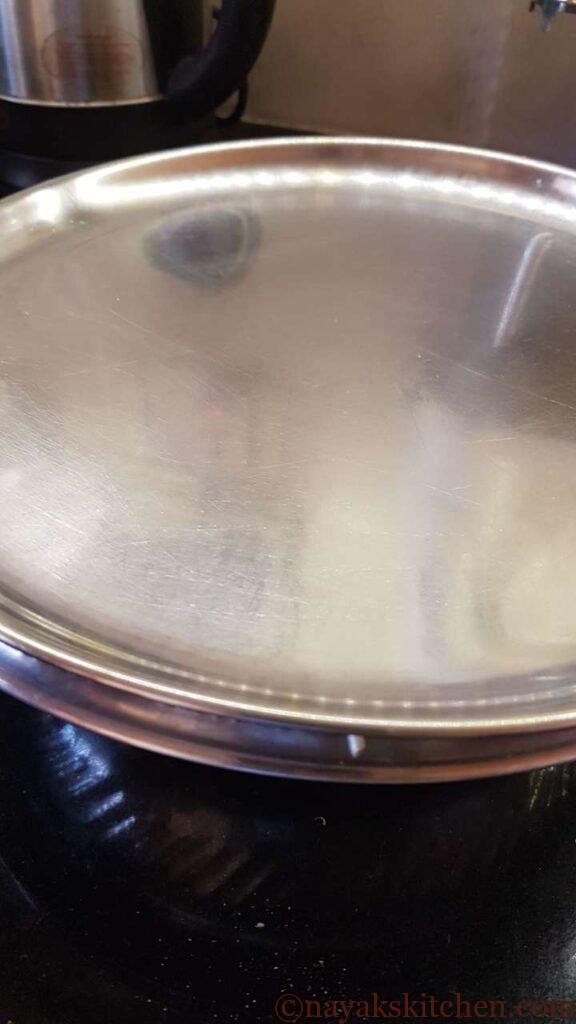
iii) Preparing fried onions
- Peel onions and wash them. Halve them and slice length-wise. Slice the onions in uniform thickness for even browning. Do not slice too thin as the onions will shrink slightly after frying.


2. Heat oil in a kadhai. Oil should be enough to immerse the onion slices. When the oil is sufficiently hot, slowly add the sliced onions in the oil.

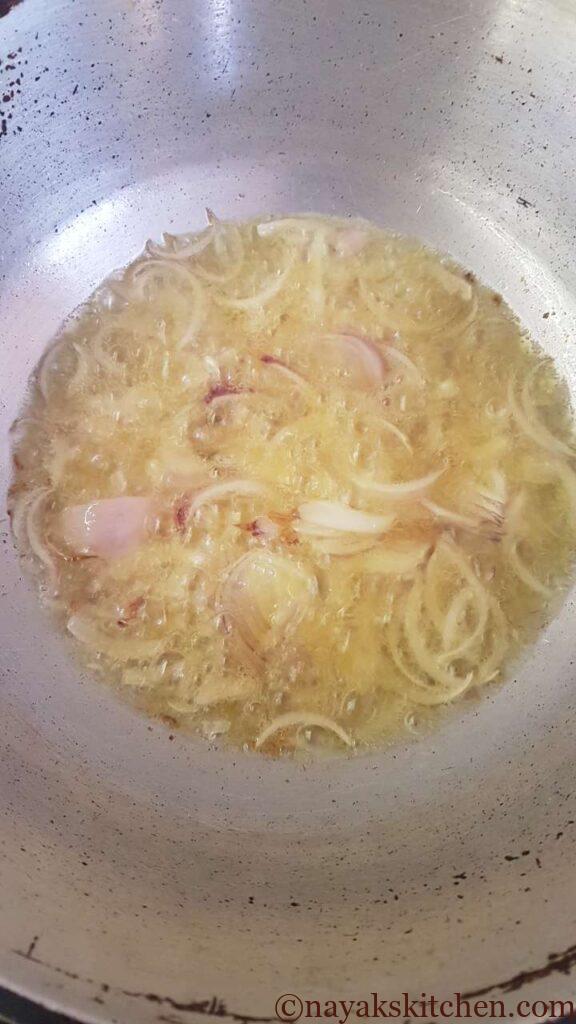
3. Keep the flame medium. Stir in between to fry evenly. Remove the fried onions once golden brown and crisp. (Do not fry for too long as the onions keep cooking further with their heat.)


4. Spread the fried onions on a plate and keep. Do not keep them together in a lump as they will become soft.

iv) Cooking Jackfruit
- Heat oil in a deep-bottomed utensil. Add chopped onion. (I have used a mud pot. A mud pot yields a flavourful biryani.)


2. Saute the onions till soft. Next add chopped tomatoes.

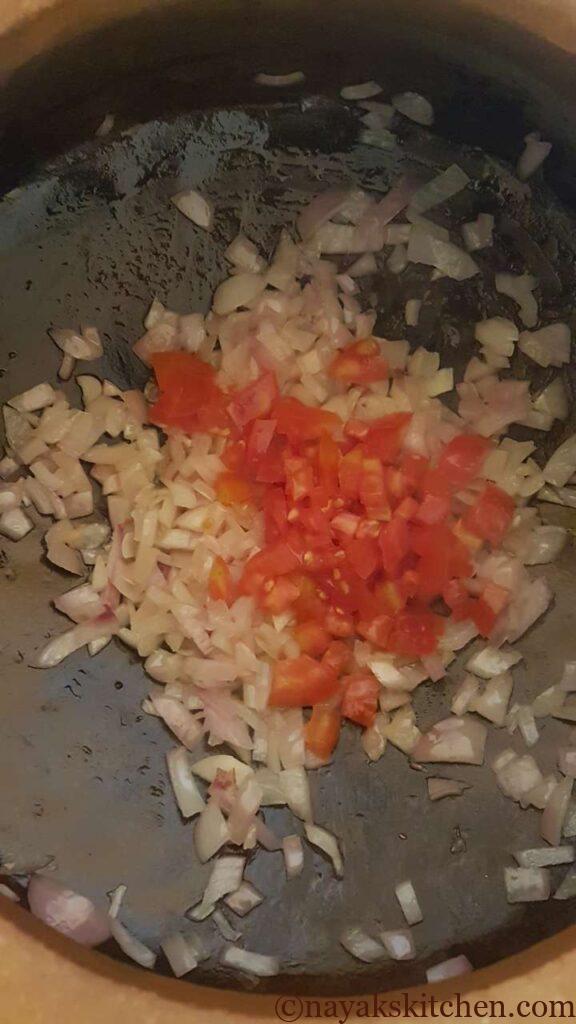
3. Once the tomatoes become soft, add tomato puree and chopped coriander. Saute for 1-2 mins.


4. Add the marinated raw jackfruit pieces. Mix everything well.


5. Add one cup water, cover and cook till the jackfruit pieces become soft. (You can also pressure cook the jackfruit mixture for 3 whistles or until soft.)


6. Check the jackfruit pieces in between. They should become soft. The time required to cook varies depending on the jackfruit. Some jackfruits take longer to cook. Once cooked, keep the pot open and cook till the gravy becomes thick.
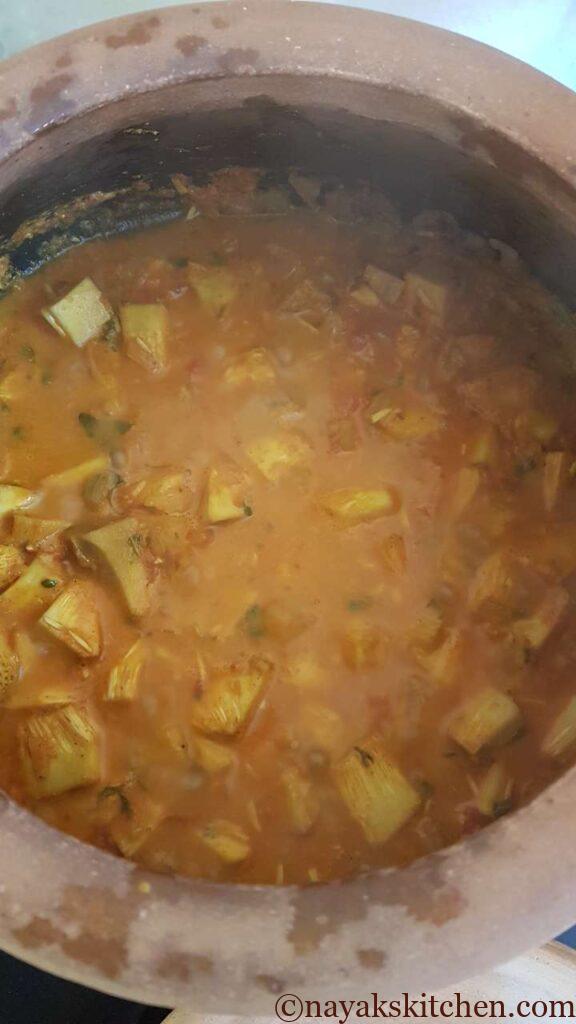

7. Once the gravy has become thick, remove half of this mixture and keep aside for layering.


v) Cooking Rice
While the jackfruit pieces cook, let’s cook the rice.
- In a deep-bottomed vessel, add water and keep it to boil. Add salt, whole spices, oil and ghee. (Skip ghee if vegan.)

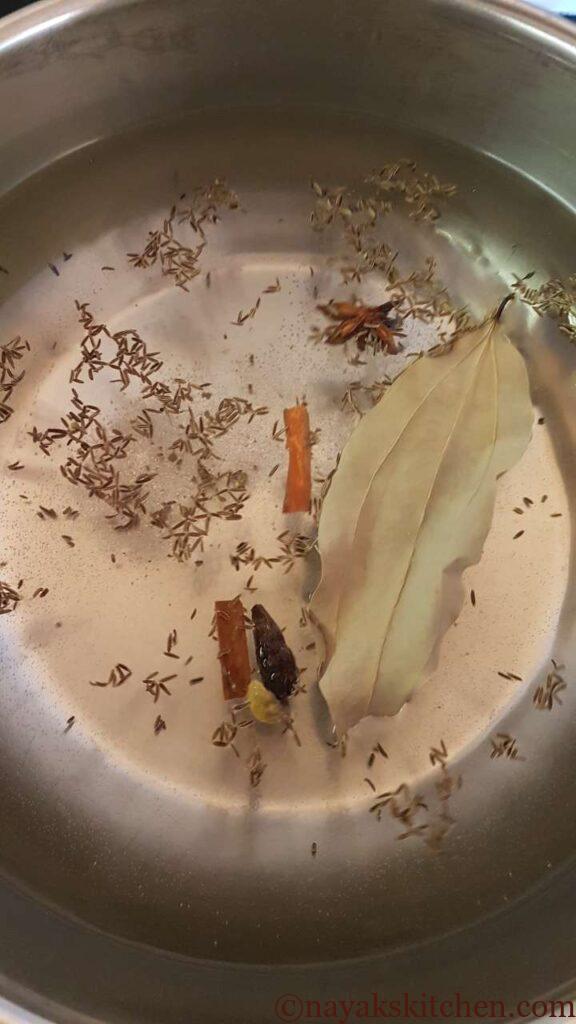


2. Add chopped mint leaves. Drain the water completely from soaked rice.


3. Bring the water to a rolling boil. Add the soaked rice to the boiling water.
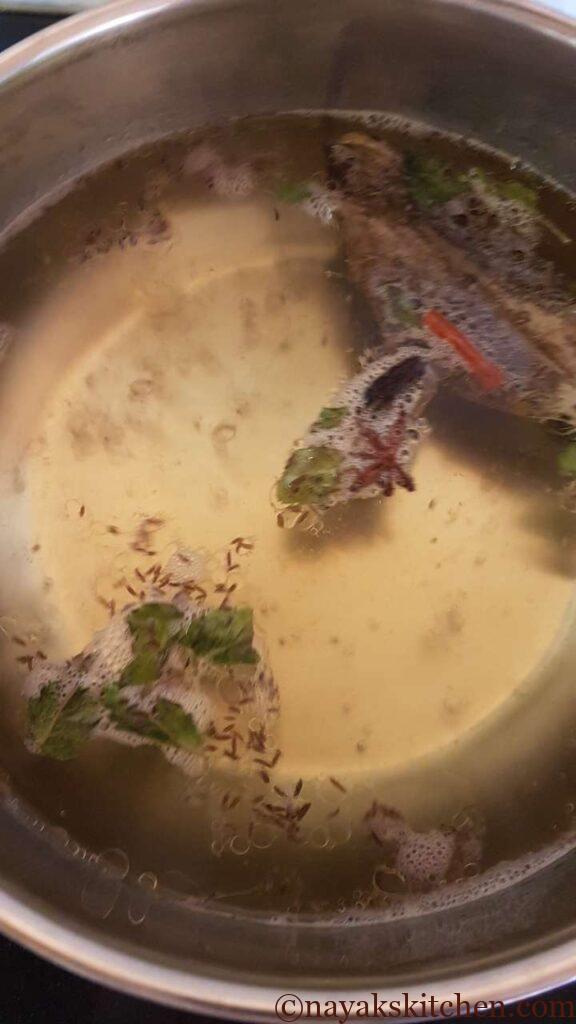

4. Mix everything well. Also, stir the rice in between.


5. Check for the water content in between. If the water becomes less, the rice will become sticky. Add some hot water if needed. (I keep water ready, heated in a kettle, to add if needed.)


6. Check the rice. It should be 80% cooked. When you press the rice grain it should break into two distinct parts. Drain the rice in a colander once done. There should be no water left in the rice.


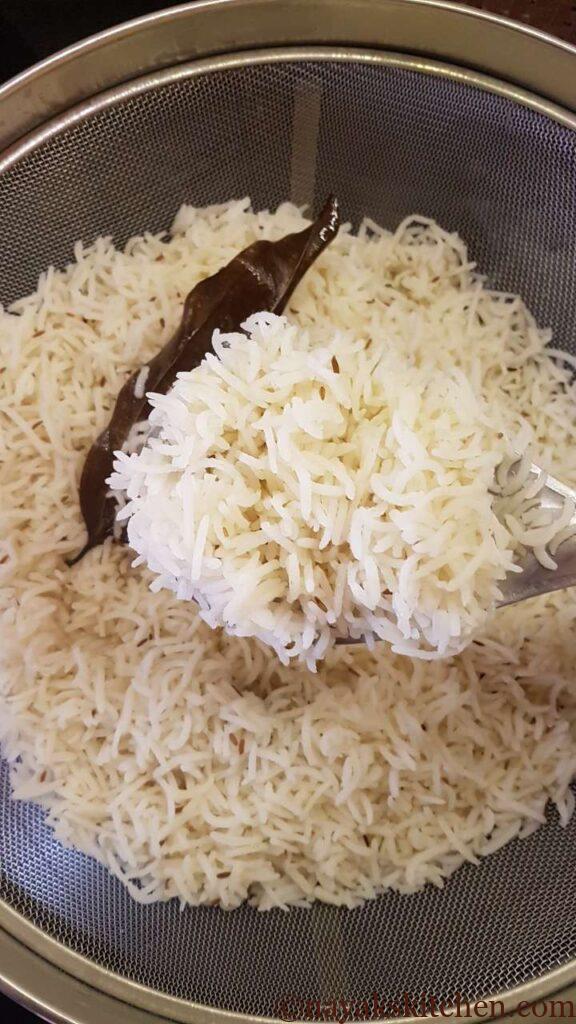
vi) Layering the Biryani
- Let’s now layer the biryani. Add half of the rice to the mud pot which has the jackfruit gravy in it.


2. Add half of the fried onions and chopped mint leaves. Next, add the remaining jackfruit gravy mixture which we had earlier set aside.


3. Add the remaining rice over the jackfruit gravy. Also, add all of the remaining fried onions or Birista.


vii) Cooking on Dum
- Add chopped mint leaves finally. Cover with a lid. You can seal it with wheat dough or place a heavy object on the lid. The lid of my mud pot is very heavy. So I did not place anything over it. Cook on dum for 20-25 mins on low flame. (To prevent burning you can place a tava beneath the pot.)


2. Switch off the gas and allow it to stand for 10 mins. Open the pot and fluff the biryani with a flat spatula or a fork to keep the grains intact. Serve hot or warm with curd, raita, pickle or papad.


(Note: If there is still some water left in the biryani, cook with the pot open till the water dries up. However, if the biryani has slightly burnt do not panic. Place the pot in a plate of water and gently scoop out the biryani in another vessel).

Raw Jackfruit Biryani | How to make Kathal Biryani?
Course: Main CourseCuisine: IndianDifficulty: Moderate5
people30
minutes45
minutes1
hour15
minutesRaw Jackfruit biryani is a vegetarian variant of chicken biryani as the succulent jackfruit pieces emulate the texture of meat.
Ingredients
1 cup = 250 ml
1 tbsp = 15 ml
1 tsp = 5 ml
- For marination
Raw Jackfruit – 1 no. (small) or 1/2 kg chunks
Curd – 1/2 cup
Ginger-garlic paste – 1 tbsp
Turmeric powder – 1/2 tsp
Chilli powder – 1/2 tsp
Coriander powder – 1/2 tsp
Biryani Masala powder – 1 and 1/2 tsp
Mint leaves – 1 tbsp (chopped)
Ghee – 1 tsp
Salt – 1/2 tsp or as per taste
- For rice
Basmati Rice – 2 cups or 1/4 kg
Water – 8 cups (to boil rice)
Salt – 1/2 tbsp
Mint leaves – 1 tbsp (roughly torn)
Oil – 1 tsp
Ghee – 1 tsp
Spices – see list below
- Whole Spices
Bay leaf – 1 no.
Shahi Jeera – 1 tsp
Black Cardamom (Badi Elaichi) – 1 no.
Green Cardamom – 2 nos.
Cinnamon – 2 small sticks
Star Anise (Dagadphool)- 1 no.
- For Fried Onions (Birista)
Onions – 3 nos. (large, sliced lengthwise)
Oil – to deep fry
- Others
Tomatoes – 1 no. (chopped)
2 nos. (pureed)
Directions
- Soaking Basmati Rice
- Clean the basmati rice and wash it twice with water. Drain the water completely. Add water again and soak it for 30 mins.
- Marinating Jackfruit
- Take the jackfruit pieces in a wide bowl and add curd. (If you are a vegan, replace with a vegan curd.)
- Add ginger-garlic paste, turmeric powder, chilli powder and coriander powder.
- Add biryani masala, chopped mint leaves (pudina), ghee and salt.
(Note: Skip ghee if you are a vegan. Check the ingredients of biryani masala for added salt. Adjust accordingly.) - Mix everything well and keep aside covered for 30 mins.
- Preparing Fried Onions (Birista)
- Peel onions and wash them. Halve them and slice length-wise. Slice the onions in uniform thickness for even browning. Do not slice too thin as the onions will shrink slightly after frying.
- Heat oil in a kadhai. Oil should be enough to immerse the onion slices. When the oil is sufficiently hot, slowly add the sliced onions in the oil.
- Keep the flame medium. Stir in between to fry evenly. Remove the fried onions once golden brown and crisp. (Do not fry for too long as the onions keep cooking further with their heat.)
- Spread the fried onions on a plate and keep. Do not keep them together in a lump as they will become soft.
- Cooking Jackfruit
- Heat oil in a deep-bottomed utensil. Add chopped onion. (I have used a mud pot. A mud pot yields a flavourful biryani.)
- Saute the onions till soft. Next add chopped tomatoes.
- Once the tomatoes become soft, add tomato puree and chopped coriander. Saute for 1-2 mins.
- Add the marinated raw jackfruit pieces. Mix everything well.
- Add one cup water, cover and cook till the jackfruit pieces become soft. (You can also pressure cook the jackfruit mixture for 3 whistles or until soft.)
- Check the jackfruit pieces in between. They should become soft. The time required to cook varies depending on the jackfruit. Some jackfruits take longer to cook. Once cooked, keep the pot open and cook till the gravy becomes thick.
- Once the gravy has become thick, remove half of this mixture and keep aside for layering.
- Cooking Rice
- While the jackfruit pieces cook, let’s cook the rice.
In a deep-bottomed vessel, add water and keep it to boil. Add salt, whole spices, oil and ghee. (Skip ghee if vegan.) - Add chopped mint leaves. Drain the water completely from soaked rice.
- Bring the water to a rolling boil. Add the soaked rice to the boiling water.
- Mix everything well. Also, stir the rice in between.
- Check for the water content in between. If the water becomes less, the rice will become sticky. Add some hot water if needed. (I keep water ready, heated in a kettle, to add if needed.)
- Check the rice. It should be 80% cooked. When you press the rice grain it should break into two distinct parts. Drain the rice in a colander once done. There should be no water left in the rice.
- Layering the Biryani
- Let’s now layer the biryani. Add half of the rice to the mud pot which has the jackfruit gravy in it.
- Add half of the fried onions and chopped mint leaves. Next, add the remaining jackfruit gravy mixture which we had earlier set aside.
- Add the remaining rice over the jackfruit gravy. Also, add all of the remaining fried onions or Birista. Also, add the chopped mint leaves.
- Cooking on Dum
- Cover with a lid. You can seal it with wheat dough or place a heavy object on the lid. The lid of my mud pot is very heavy. So I did not place anything over it. Cook on dum for 20-25 mins on low flame. (To prevent burning you can place a tava beneath the pot.)
- Switch off the gas and allow it to stand for 10 mins. Open the pot and fluff the biryani with a flat spatula or a fork to keep the grains intact. Serve hot or warm with curd, raita, pickle or papad.
- If there is still some water left in the biryani, cook with the pot open till the water dries up. However, if the biryani has slightly burnt do not panic. Place the pot in a plate of water and gently scoop out the biryani in another vessel.
Notes
- Selecting the raw jackfruit – Always select an unripe, young jackfruit that is hard and firm to touch.
- Jackfruit Seeds – Use the jackfruit seeds if they are tender, and their outer hard covering has not formed yet.
- Cooking the jackfruit – Raw jackfruit takes a long time to cook in an open pan. You can pressure cook it till tender, to reduce the cooking time. If cooking in an open pot, do check in between for water content. If required add a little water.
- Soaking the rice: Soak the rice for a minimum of 30 minutes before cooking. Soaking will cook the rice evenly and prevents it from becoming mushy. It also will give you rice that is fluffy and has long grains.
- Cooking the rice – The rice should be 80% cooked as it will cook further after layering the biryani and while cooking on dum.
- Use whole spices such as cardamom, cloves, cinnamon, and bay leaves to instill the biryani with a fragrant aroma.
- Biryani Masala: Use good-quality biryani masala. Your biryani’s taste and flavour will depend on the masala that you use.
- Salt – Be careful while adding salt. Most biryani masalas have added salt in them. Check for the ingredients on the label before adding additional salt.
- Layer the biryani: Layering the biryani by alternating between the rice and jackfruit mixture will ensure that the flavours are evenly distributed through the rice.
- Fried Onions: This is one of the most important and the secret to a delectable biryani. Do not skip it.
- Mint and Coriander – Add the required freshness and also balance the hot spices that might overpower the biryani.
- Use a heavy-bottomed pot: This will prevent the rice from sticking to the bottom and burning. You can even use a mud pot.
- Cook on low heat: Cooking the biryani on low heat and dum ensures that the rice is cooked evenly and doesn’t get overcooked and subsequently mushy.
- Allow it to rest: After cooking the biryani, let it rest for at least 10-15 minutes before serving. This will infuse the aroma in the biryani.
Other Jackfruit Recipes
Chaako (Raw Jackfruit Vegetable)


Ripe Jackfruit Recipes
Jackfruit Patholi (Panasa Patholi)
